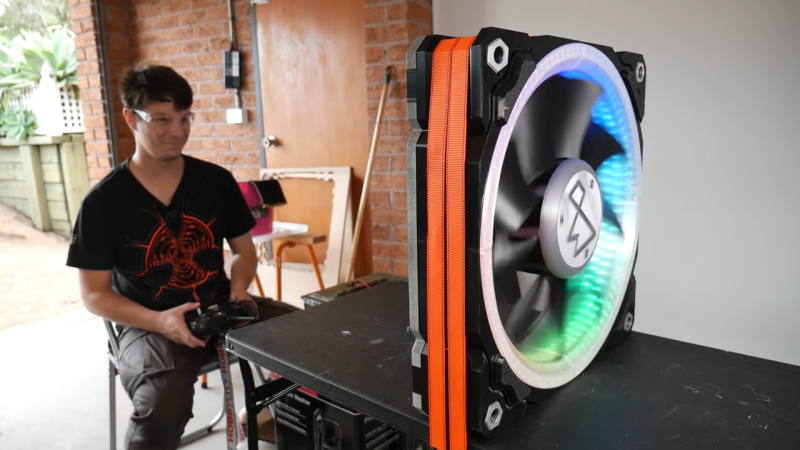It’s getting close to the time of year when we need to start carefully vetting projects here at Hackaday. After all, nobody likes to get punked by an early April Fool’s joke. But as silly as this outsized PC fan looks, it sure seems like a legit build, if a bit on the pointless side.
Then again, perhaps pointless is too harsh a word to use. This 500-mm fan is by [Angus] over at Maker’s Muse, and it represents a lot of design work to make it buildable, as well as workable and (mostly) safe. Using both CNC-cut MDF and printed parts, the fan is an embiggened replica of a normal-sized case fan. The fan’s frame had to be printed in four parts, which lock together with clever interlocking joints. Each of the nine blades locks into a central hub with sturdy-looking dovetails.
And sturdy is important, as the fan is powered by a 1,500 Watt brushless DC motor. With a 4:1 reduction thanks to a printed gear train, the fan spins at around 3,300 RPM, which makes a terrifying noise. There’s a little bit of “speed-wobble” evident, but [Angus] managed to survive testing. The fan, however, did not — the 3D-printed gears self-destructed after a full-speed test, but not before the fan did its best wind tunnel imitation. And the RGB LEDs looked great.
This one reminds up of something we might see [Ivan Miranda] come up with. In fact, his super-sized 3D printer might have been just the thing to shorten [Angus]’ print times.
















I am a bit of a Makers Muse fan!
Wait, what’s this about a MDF cutter bit that cuts up and down at the same time? (3:20)
They are called “compression” bits. When you run them at full depth, the tip end has a spiral that “up” cuts, while the shank end has a spiral that “down” cuts. Really reduces the tear out when cutting. If you run them at anything less than full depth though, you don’t get the benefit, so make sure your tool can handle the material.
Yep and they truly and literally pack the kerf full of chips which can actually help keep parts from rattling around in the sheet as they are cut out. Compression bits are wonderful and super important for high end plywood work especially.
My tool is just fine, thank you.
Actually, put grilles on both sides, slow it down a bit, mount it on a pedestal, could be a decent home-made fan + mood light.
So as “silly” as this is, it actually isn’t far off being a saleable concept.
+1 Make it so!
If you go this far then you just have to add LED’s on the fan blades to make a POV display. Would have to make sure things are balanced. Things that aren’t balanced tend to dis-integrate at those RPMs.
He could make a giant brushless motor (just like the computer fan’s actual one) to go along with it.
Those little metal inserts for screwing bolts into the plastic, are a lot easier to sink into place, if you just stick them on the end of a soldering iron and push them in. No faffing around with a blowtorch or a hot air gun and no mad rush, to get the positioning perfect, before it cools down.
M10!?!
they are not exactly that little :) I think MM knows them well but this is the obvious solution.
They were for a M10 or bolt with a 10mm shank / thread.
Here they’re called Gyprock nutserts. Gyprock is like drywall. I’m not sure. English is my fourth language after Australia, Canadian, American.
Awesome! By that count I ‘have’ more than just two languages – maybe even up to 5.
Seems much larger then 500mm. Closer to 1kmm